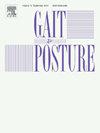髋关节外展肌在等长次最大负荷任务中的神经肌肉控制的性别差异。
IF 2.2
3区 医学
Q3 NEUROSCIENCES
引用次数: 0
摘要
背景:文献中的一个重点是需要更好地了解男性和女性如何进行神经肌肉控制,这就需要考虑肌肉形态,因为肌肉形态可能会改变发力过程中的神经驱动力。尽管之前的研究主要集中在膝关节和踝关节周围的肌肉,但探索其他肌肉(如髋关节外展肌)的行为也至关重要,因为许多女性更常见的下肢疾病都与髋关节肌肉的改变有关:男性和女性在进行亚极限等长任务时,髋关节外展肌的肌电图(EMG)变量(振幅、低频带和高频段)是否不同?肌肉大小与这些任务中的 EMG 反应有何关联?对 36 名参与者(男性,n = 18;女性,n = 18)测量臀中肌(GMed)和腹筋膜张力(TFL)的肌肉和皮下厚度。然后,他们在侧卧位髋关节外展运动中进行了估计的单次最大负重(1RM)测试,接着进行了两项 10 秒钟的次最大负重任务:(i) 侧卧位髋关节外展,1RM 为 50%;(ii) 1RM 为 20%。对 GMed 和 TFL 肌电图振幅和频带(低频和高频成分)进行了分析:在两项任务中,女性的 GMed 肌电图振幅、低频成分和高频成分均高于男性(p = 0.001-0.040)。在 TFL EMG 变量中未观察到差异。在 50 % 1RM 任务中,GMed 厚度越大,振幅越低(r = - 0.35; p = 0.03),而 TFL 厚度越大,低频越低 [20 % 1RM: r = - 0.70; p = 0.002; 50 %-1RM: r = - 0.65; p = 0.005]和较高的高频成分[20 % 1RM: r = 0.74; p = 0.001; 50 %-1RM: r = 0.76; p < 0.001]:男性和女性采用不同的神经肌肉控制策略,不同的协同者在髋关节外展时的策略也不同。本文章由计算机程序翻译,如有差异,请以英文原文为准。
Sex-differences in neuromuscular control of hip abductors during isometric submaximal tasks
Background
One key focus in the literature is the need to better understand how males and females perform neuromuscular control, which requires consideration of muscle morphology, as it may change neural drive during force production. Although previous studies focused on muscles around the knee and ankle, it is crucial to explore the behavior of other muscles, such as the hip abductors, since many lower limb conditions more common in females have been associated with alterations in hip muscles.
Research questions
Are electromyography (EMG) variables (amplitude and low- and high frequency bands) of hip abductors during submaximal isometric tasks different between males and females? How is muscle size associated with EMG responses during these tasks?
Methods
Thirty-six participants (males, n = 18; females, n = 18) had muscle and subcutaneous thickness of gluteus medius (GMed) and tensor fascia latae (TFL) measured. They then performed an estimated one-repetition maximum (1RM) test in a side-lying hip abduction exercise, followed by two 10-s submaximal tasks: (i) side-lying hip abduction with 50 % 1RM and (ii) with 20 % 1RM. GMed and TFL EMG amplitude and frequency bands (low and high frequency components) were analyzed.
Results
Females had higher GMed EMG amplitude, lower low-frequency, and higher high-frequency components than males in both tasks (p = 0.001–0.040). No differences were observed in TFL EMG variables. Greater GMed thickness was associated with lower amplitudes in the 50 % 1RM task (r = − 0.35; p = 0.03), while greater TFL thickness was associated with lower low-frequency [20 % 1RM: r = − 0.70; p = 0.002; 50 %-1RM: r = − 0.65; p = 0.005] and higher high-frequency components [20 % 1RM: r = 0.74; p = 0.001; 50 %-1RM: r = 0.76; p < 0.001] only in females.
Significance
Males and females employ different neuromuscular control strategies, which vary among the synergists for hip abduction.
求助全文
通过发布文献求助,成功后即可免费获取论文全文。
去求助
来源期刊

Gait & posture
医学-神经科学
CiteScore
4.70
自引率
12.50%
发文量
616
审稿时长
6 months
期刊介绍:
Gait & Posture is a vehicle for the publication of up-to-date basic and clinical research on all aspects of locomotion and balance.
The topics covered include: Techniques for the measurement of gait and posture, and the standardization of results presentation; Studies of normal and pathological gait; Treatment of gait and postural abnormalities; Biomechanical and theoretical approaches to gait and posture; Mathematical models of joint and muscle mechanics; Neurological and musculoskeletal function in gait and posture; The evolution of upright posture and bipedal locomotion; Adaptations of carrying loads, walking on uneven surfaces, climbing stairs etc; spinal biomechanics only if they are directly related to gait and/or posture and are of general interest to our readers; The effect of aging and development on gait and posture; Psychological and cultural aspects of gait; Patient education.
 求助内容:
求助内容: 应助结果提醒方式:
应助结果提醒方式:


